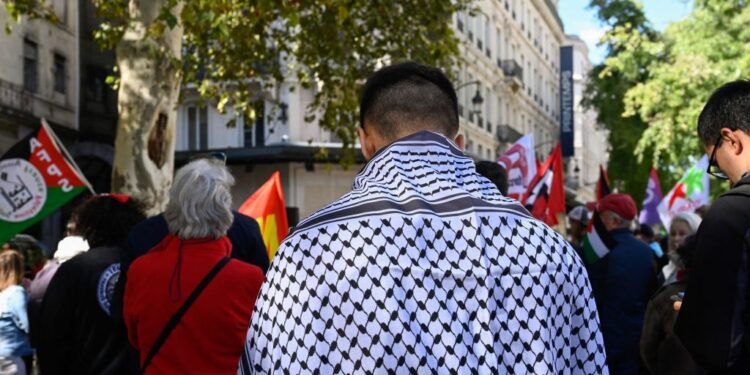Once used for sun protection from the blistering sun in Southwest Asia and North Africa, the kaffiyeh’s function, and symbolism, has undeniably transformed over time. It’s been spotted on high-fashion Palestinian supermodel Bella Hadid, on the necks of students at college encampments, and covering the faces of activists at pro-Palestinian marches. It’s been sold on the shelves of Urban Outfitters and Louis Vuitton, and subject to bans by the Australian state of Victoria, which barred legislators from wearing the scarf in parliament because of its “political” nature.
And in recent decades it has become widely recognized as a symbol of Palestinian nationalism and resistance. The link far predates the Israel-Hamas War, which has taken the lives of more than 40,000 Palestinians since Oct. 7, when 200 Israelis were taken hostage and more than 1,000 were killed on the night. Just last week, the Noguchi Museum in New York City fired three employees for wearing it to work, banning clothing associated with “political messages, slogans or symbols.”
For Palestinians, the symbolism of the kaffiyeh can also be deeply personal. “I embroidered my kaffiyeh with tatriz, which is the word for embroidery in Arabic, to express my connection to my homeland, not just as a symbol of resistance to what is happening today in the Israeli occupation, but as an expression of myself,” says Wafa Ghnaim, a Palestinian dress historian and researcher.
What is the kaffiyeh?
The kaffiyeh is a square-shaped hand-woven checkered scarf with a wavy motif around the border– representing olive leaves—and oftentimes tassels along opposite sides. (Olive trees, which have been growing in Gaza and the West Bank for centuries, are a pivotal part of both Palestinian culture and the local economy.)
Though historically an Arab male headdress, today the kaffiyeh is worn by people of all races and genders across Southwest Asia, Northern Africa and beyond. “There used to be many different patterns, sometimes different colors and designs. But the idea was having a scarf that was useful within a hotter climate,” says Haitham Kuraishi, a tour guide at the Museum of the Palestinian People.
The black-and-white kaffiyeh is the one most commonly worn by Palestinians and those who wear the scarf in solidarity with the people living under tumult in the Gaza Strip. But other predominant colors of the kaffiyeh are popular in other territories. The red kaffiyeh, for instance, is more popular in Jordan, suggests Kuraishi.
A clothing item that dates back centuries
Kaffiyehs were first worn by Sumerians, part of an ancient civilization dating back to 4500 BCE, in what was then-known as Mesopotamia, according to Kuraishi. The scarf then took off among Bedouins, indigenous people in the desert regions of the Arabian Peninsula, partly due to its practical uses. “If you were trudging through the desert, you could also use that scarf to cover your mouth from a dust storm, or a sandstorm, and [it was] also a way of just having shade,” says Kuraishi. Until the early 20th century, kaffiyehs were primarily worn by Bedouins, to distinguish nomadic men from the villagers and townsmen, according to Ghnaim.
That changed after World War I when the League of Nations issued the British Mandate for Palestine, which was drawn up in 1920 and granted Britain responsibility for the territory that then comprised Palestine. That mandate also called for the establishment of a “national home for the Jewish people,” according to the document. The resulting tumult broiled into the Arab Revolt of 1936-1939, which marked the first “sustained violent uprising of Palestinian Arabs in more than a century,” in a call for Palestinian sovereignty and independence, says Kuraishi.
“Palestinian men put on the kaffiyah, and not just on their head, around their neck, as almost a uniform,” adds Ghnaim. The kaffiyeh thus became a symbol of solidarity uniting working class Palestinians with the upper-class, who would typically also wear a fez.
Other prominent figures also popularized the scarf in the years to follow. Former President of the Palestinian Authority Yasser Arafat, who once graced the cover of TIME magazine with the kaffiyeh in 1968, was well-known for wearing the scarf on his head in a triangular shape that mimicked the shape of Palestine, Ghnaim says. In the 1960s, Leila Khaled, a “freedom fighter” and leader of the Popular Front for the Liberation of Palestine—which the U.S. designated a terrorist group—also wore the kaffiyeh. “That move of wearing [the kaffiyeh] on her head as a woman, like a hijab, garnered a lot of attention [and] widespread popularity around the world, but also in the Palestinian community [and] diaspora,” adds Ghnaim.
Recent adoption
The scarf has resurged in the fashion world several times in recent decades. In 1988, the same year that the Palestine National Council announced the establishment of the State of Palestine following a staged uprising against Israel, TIME wrote about the scarves’ adoption by the American public. Then, TIME reporter Jay Cocks argued that the kaffiyeh, once a “garment of choice among the political protesters and antimissile advocates of the ‘70s and early ‘80s” had become “politically neutral.”
That connotation doesn’t remain true today. In 2007, the New York Times reported that kaffiyehs were marketed as “antiwar” scarves by Urban Outfitters, though they were later pulled from stores “due to the sensitive nature of this item.”
Today, many Palestinians recognize that while the checkered scarf is a symbol of resistance, it’s still undeniably tied with their own cultural heritage.
“While other Arabic-speaking nations might have a similar pattern or design, [the kaffiyeh] doesn’t have that added meaning of resistance against occupation and invasion that it does amongst Palestinians,” says Kuraishi. “Palestinians will wear it for weddings or graduations, not just protests—so good times and bad.”






